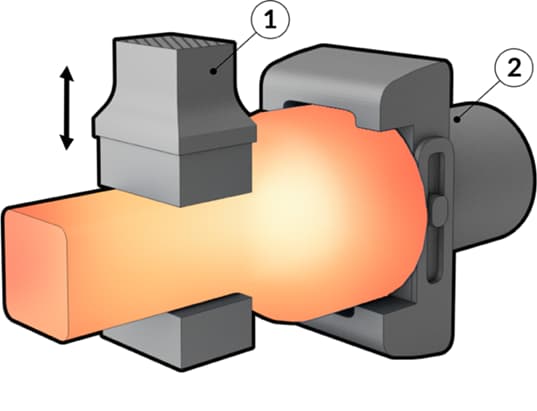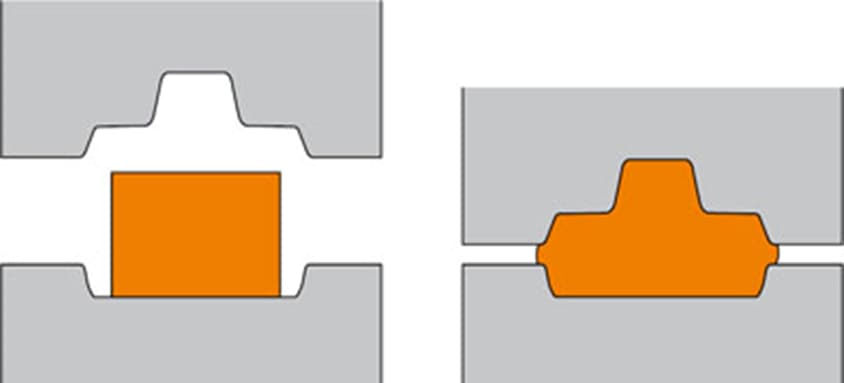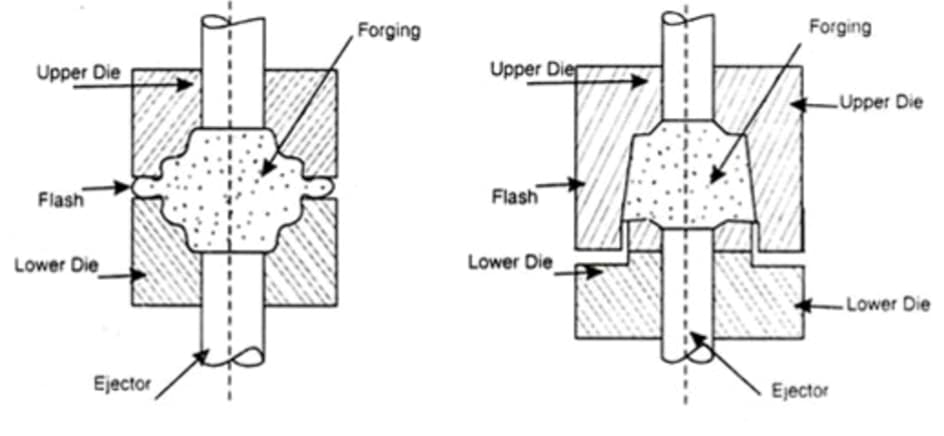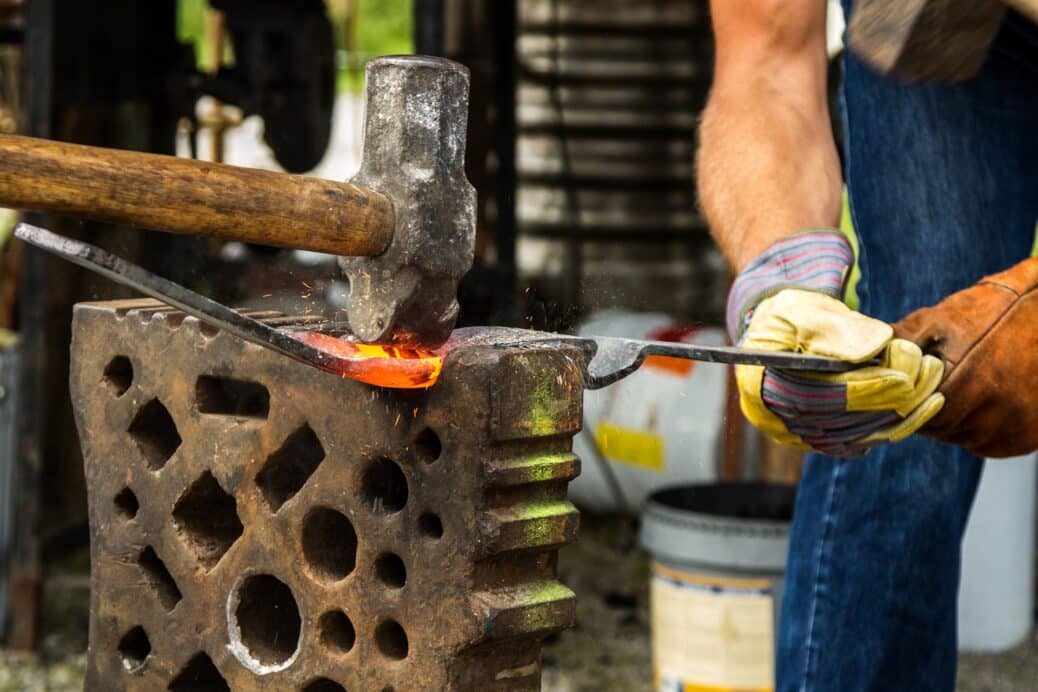1. Drop Forging
Drop forging may be a metal forming process. A workpiece is inserted into a die then hammered until it’s assumed the form of the die. The lower die could be a stationary part, while the upper part may be a moving hammer dropped onto the workpiece so as to deform it. Drop forging are oftenperformed both at high or ambient temperature. This manufacturing process includes a long tradition within themetal shaping industry and it’s been used for many years. The mechanics of the method are still the identical, but all involved machinery has greatly advanced to show drop forging into a high-precision manufacturing process. The same as all other forging techniques, drop forging enhances the fabric properties of the ultimate piece.
There are two main tools used in forging machines to deform a stock through extensive forces; for example, hammer or press. Drop hammer hammers and press machines can produce the same results as the way the force is transmitted from the forging die to the metal part is fundamentally different, but the difference is that a forging hammer affects the workpiece as a machine not by continuous pressure but by sequential blows.
Consistent with the way a hammer is attached and also theway it deforms the workpiece, there are differing types of forging hammers: drop forging hammers are simplest configuration for forging is dole out on a particular hammer and anvil, A lower die is fixed on the anvil and an upper (moving) die is fixed on the ram and the ram and upper die transfer fast-speed mechanical energy to the work piece, placed within the lower die and anvil. The anvil configuration has to provide a awfully solid base, since it absorbs an enormous amount of the energy. Therefore the anvils’ weight is sometimes ten to twenty times quite the burden of the hammer. Double-Acting Forging Hammer configuration is comparable to the primary one, but the hammer fixed on the ram is accelerated when falling by air or steam; respectively a hydraulic or pneumatic forging hammer. Double-action forging hammers are very powerful and gradually replace simpler configurations, and there is no anvil in the Counterblow Forging Hammer configuration. However, there are two hammers fixed on two rams, achieving opposite directions that allow the workpieces to be precisely formed[3].
These are the foremost complex forging hammers and that they allow very large forging energy levels to be achieved. In terms of the position of the dies, there are two main kinds of drop forging: open-die drop forging and closed-die drop forging, also called impression-die forging.
Open-Die Forging
This is additionally called smith forging. In open die forging, a hammer hits and deforms the workpiece placed on a stationary anvil; it also gets its name from the fact that dies do not surround the workpiece and allow dies to flow outside where they come into contact, so it must orient and position the workpiece so that it forces the specified shape. Molds are flat. However, some have a specially shaped surface for special processes; For example, a die may have a round, concave or convex surface, or a tool or a cutting tool for forming holes. Open die forgings work on sections such as discs, hubs, blocks, shafts, sleeves, cylinders, flats, hexagons, circles, plates.

In some cases, open-die forging could also beemployed to rough-shape ingots to organize them for subsequent operations. Open-die forging may orient the grain to extend strength within the required direction. Advantages of open-die forging; reduce chance of voids, good fatigue resistance, continuous grain flow, finer grain size, greater strength, better response to thermal treatment, improvement of internal quality, greater reliability of mechanical properties, ductility and impact resistance. “Cogging” is that the successive deformation of a bar along its length using an open-die drop press. It is commonly accustomed work a bit of staple to the correct thickness. Once the correct thickness is achieved the right width is achieved via “edging”. “Edging” is that the process of concentrating material employing a concave shaped open-die, the method is named “edging” because it’s usually disbursed on the ends of the workpiece. “Fullering” could be asimilar process that thins out sections of the forging employing a convex shaped die and these processes prepare workpieces for further forging processes.
Impression-Die Forging
Impression-die forging is additionally called “closed-die forging”. In impression-die forging, the metal is placed during a die resembling a mold, which is attached to an anvil. Usually, the hammer die is formed also and dropped on the workpiece, causing the metal to flow and fill the die cavities. The hammer is mostly up-to-date with the workpiece on the dimensions of milliseconds, looking on the scale and complexity of the part, the hammer is also dropped multiple times in quick succession. Excess metal is squeezed out of the die cavities, forming what’s spoken as “flash”. The flash cools faster than the rest of the material. This cold metal is stronger than the metal in the mold and the result of this helps to prevent excessive flashing, while also forcing the metal to fill the mold cavity completely. It is used to distribute metal into subsequent cavities to the shape of the container and is referred to as “edge”, “plump” or “bent” impression.

The subsequent cavities are called “blocking” cavities, during which the piece is functioning into a shape that more closely resembles the ultimate product. These stages usually impart the workpiece with generous bends and huge fillets. The ultimate shape is forged during a”final” or “finisher” impression cavity. If a short part is to be run, the mold should lack a final gauge gap and instead it should be more economical to process the final features. Impression die forging has been improved through direct heat treatment of parts after forging, due to the increased automation with heating and manipulation in recent years, mechanical feeding, positioning. During this type of forging, the die cavities are completely closed, which prevents the workpiece from flashing. The most important advantage of this process is that it minimizes much less metal loss during ignition. The flash can make up almost 50% of the starting material, the disadvantages of this process include the additional cost due to a complex mold design and even the need for better lubrication and workpiece placement. There are also other variations of part formation that integrate the impression die forging process. A different method involves pouring a forging die out of liquid metal.
The casting is removed after it’s solidified, but while still hot. It is then finished in an exceedingly single cavity die. Flash is cut, then the part is quenched and hardened. Another mode of operation is the same, except that metal droplets are produced by spraying the collectors. Closed die forging requires a design process to create cavities in the working mold and involves a high initial cost of forming dies, but becomes economical when large production is made as there are low recurring costs for each part.
This is often one in all the main reasons closed-die forgings are often utilized in the automotive and gear industries. One more reason forgings are common in these industrial sectors is that forgings generally have a couple of 20 percent higher strength-to-weight ratio compared to cast or machined parts of the identicalmaterial. Design of impression-die forgings and tooling. Forging dies are usually manufactured from high-alloy or alloy steel. Dies can be impact and wear-resistant, maintain strength at high temperatures, have the power to resist cycles of rapid heating and cooling; that is to say, as to provide a far better, more economical die the subsequent standards are maintained: the dies part along one, flat plane whenever possible. If not, the parting plane follows the contour of the part, the parting surface may be a plane through the middle of the forging and not near an upper or lower edge, adequate draft is provided; usually a minimum of 3° for aluminium and 5° to 7° for steel, generous fillets and radii are used, ribs are low and wide[6]. The various sections are balanced to avoid difference in metal flow, dimensional tolerances can not closer than necessary. Barrelling occurs when, because of friction between the work piece and therefore the die or punch, the work piece bulges at its centre in such some way on resemble a barrel. This ends up in the central a part of the work piece to come backin touch with the perimeters of the die ahead of if there have been no friction present, creating a far greater increase within the pressure required for the punch to complete the forging. Dimensions contained within a mold part stand at a substantially high level of accuracy.
2. Press Forging
Press forging is placed between dies. It is the process of forming a metal by applying mechanical or hydraulic pressure. Press forging is done in a forging press and is a machine that results in gradual pressure on the forging dies; furthermore, the shape of the metal is made by a press stroke, processing for each mold station. The difference between impact forging and press forging is that in impact forging, a rapid impact force is applied to the die, but in press forging, a gradually increasing pressure is applied to the die. Press forging is suitable for forging efficiency for large-volume materials, and is a technique that gradually applies pressure to a die holding a workpiece, and this process is suitable for forging in open die or closed die; Open die press forging is a process in which the metal is surrounded by a die on one side. First, in the impression mold and closed die forging methods, the metal material is taken into a mold, then pressure is applied to the mold, then the plastic deformation of the material occurs and fills the mold cavities. The closed mold method causes less flash than forging in the open mold; Also, some of the press forging methods using closed dies are coining and hubbing.

The hubbing is pressed into the mold so that the mold flows into the mold cavities, and this process is often used in silverware making.
The three main types of forging presses used for press forging are listed below:
- Mechanical Press – converts the rotation of the motor into linear motion of the ram.
- Hydraulic Press – hydraulic motion of the piston moves the ram.
- Screw press – screw mechanism actuates the ram movement.
Advantages of forging pressing are as follows; Suitable for controlling the compression ratio of the workpiece, economically suitable for high volume production, most shapes can be made, and produce less scrap.
3. Upset Forging
Upset forging which is a manufacturing process, that plastically deforms metal under high pressure into good strength components of varying sizes and this forging process is right for extended shapes where just one end of part has tobe forged. Upset forgings can be made by gathering material to a delegated area of a carbon, alloy, and stainless-steel bar. The press accustomed manufacture these components operates on a horizontal plane. The dies are split to permit material to protrude beyond the machine, and a few of the forming force is provided by a third die attached to the header.
4. Roll Forging
Roll forging could be a process where round or flat bar stock is reduced in thickness and increased long. Roll forging is made using a cylindrical or semi-cylindrical roller with grooves; Further, a heated rod is inserted into the rollers, after which the rollers rotate, gradually shaped as it is rolled on the machine.
The piece is then transferred to the following set of grooves or circled and reinserted into the identical grooves. This continues until the specified shape and size is achieved. The advantage of this process is there’s no flash and it imparts a good grain structure into the workpiece. For example, for this method include axles, tapered levers and leaf springs.
5. Net-Shape And Near-Net-Shape Forging
This process is additionally referred to as precision forging. It absolutely was developed to attenuate cost and waste related to post-forging operations. Therefore, the ultimateproduct from a precision forging needs little or no final machining. Cost savings are gained from the utilization of less material, and thus less scrap, the decrease in energy used, and therefore the reduction or elimination of machining. Precision forging require less of a draft, 1° to 0°. The downside of this process is its cost, therefore it’s only implemented if significant cost reduction are often achieved. Cold forging Near net shape forging is most typical when parts are forged without heating the slug, bar or billet. Aluminum could be acommon material which will be cold forged counting on final shape. Lubrication of the parts being formed is critical to extend the lifetime of the mating dies[8].
6. Isothermal Forging
Isothermal forging is a hot machining process that tries to look at the workpiece at high temperature, and this can be achieved by heating the die to or slightly below the initial workpiece temperature; furthermore, cooling of the workpiece between the mold work interface is eliminated as the forces applied by the mold create the work. As a result, the flow properties of the metal are significantly improved.
Isothermal forging may or might not be performed in a veryvacuum. Equipment costs for this manufacturing process are high, and also the added expense of this kind of operation should be justified on a case by case basis. The benefits of isothermal forging are its low machining requirements, low scrap rates, part repeatability and, finally, close to clear shapes, which encourage the use of small machines for forging due to low heat loss[9]. There are also disadvantages, these are; higher die material costs because of the temperature and pressure, require uniform heating systems, protective atmospheres or vacuum to reduce oxidation of the dies and material, and low production rates.
For further information please read: What Is Forging?
Read more: Forge Materials And Applications
References
[1] Cast steel: Forging, archived from the original on 18 February 2009, retrieved 3 March 2010
[2] Retriewed from: https://www.forginal-industrie.com/en/expertise/technical-forging/
[3] Kaushish, J. P. (2008), Manufacturing Processes, PHI Learning, p. 469,
[4] Retriewed from: https://www.manufacturingguide.com/en/open-die-forging
[5]Retriewedfrom:https://www.schulergroup.com/major/us/technologien/produkte/grundlagen_massivumformung_gesenkschmieden/index.html
[6] 50,000 Ton Closed Die Forging Press (PDF). American Society of Mechanical Engineers. 1981. Archived from the original (PDF) on 2012-02-27. Retrieved 2012-05-15.History of the Mesta Press at Alcoa
[7] Retriewed from: https://thepipefitting.com/what-is-press-forging-process.html
[8] Degarmo, E. Paul; Black, J. T.; Kohser, Ronald A. (2011). Materials and Processes in Manufacturing (11th ed.). Wiley
[9] Retriewed from: https://www.qcforge.com/forging-knowledge/
[10] Doege, E., Behrens, B.-A.: Handbuch Umformtechnik: Grundlagen, Technologien, Maschinen (in German), Springer Verlag, 2010, p. 7


